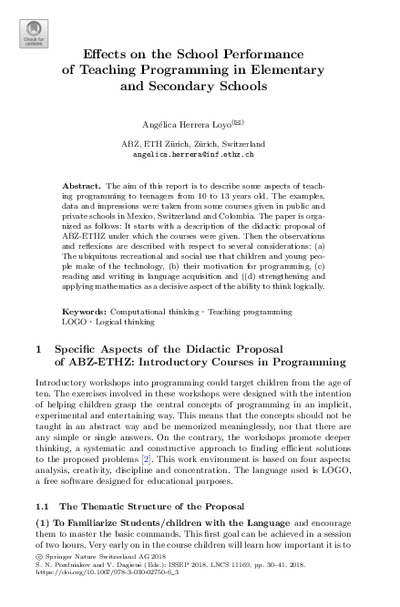Effects on the School Performance of Teaching Programming in Elementary and Secondary SchoolsAngélica Herrera Loyo
Zu finden in: Informatics in Schools: Fundamentals of Computer Science and Software Engineering (Seite 30 bis 41), 2018
  |
 |
 Diese Seite wurde seit 3 Jahren inhaltlich nicht mehr aktualisiert.
Unter Umständen ist sie nicht mehr aktuell.
Diese Seite wurde seit 3 Jahren inhaltlich nicht mehr aktualisiert.
Unter Umständen ist sie nicht mehr aktuell.
 Zusammenfassungen
Zusammenfassungen
 The aim of this report is to describe some aspects of teaching programming to teenagers from 10 to 13 years old. The examples, data and impressions were taken from some courses given in public and private schools in Mexico, Switzerland and Colombia. The paper is organized as follows: It starts with a description of the didactic proposal of ABZ-ETHZ under which the courses were given. Then the observations and reflexions are described with respect to several considerations: (a) The ubiquitous recreational and social use that children and young people make of the technology, (b) their motivation for programming, (c) reading and writing in language acquisition and ((d) strengthening and applying mathematics as a decisive aspect of the ability to think logically.
The aim of this report is to describe some aspects of teaching programming to teenagers from 10 to 13 years old. The examples, data and impressions were taken from some courses given in public and private schools in Mexico, Switzerland and Colombia. The paper is organized as follows: It starts with a description of the didactic proposal of ABZ-ETHZ under which the courses were given. Then the observations and reflexions are described with respect to several considerations: (a) The ubiquitous recreational and social use that children and young people make of the technology, (b) their motivation for programming, (c) reading and writing in language acquisition and ((d) strengthening and applying mathematics as a decisive aspect of the ability to think logically. Dieser wissenschaftliche Zeitschriftenartikel erwähnt ...
Dieser wissenschaftliche Zeitschriftenartikel erwähnt ...
 Personen KB IB clear | Jean Piaget | ||||||||||||||||||
 Begriffe KB IB clear |  Kinder Kinder children
, children
,  Kreativität Kreativität creativity
, creativity
,  LOGO (Programmiersprache) LOGO (Programmiersprache) LOGO (programming language)
, LOGO (programming language)
,  Mathematik Mathematik mathematics
, mathematics
,  Motivation Motivation motivation
, motivation
,  Programmieren Programmieren programming
, programming
,  Schule Schule school
, school
,  Schweiz Schweiz Switzerland Switzerland
| ||||||||||||||||||
 Bücher |
|
 Dieser wissenschaftliche Zeitschriftenartikel erwähnt vermutlich nicht ...
Dieser wissenschaftliche Zeitschriftenartikel erwähnt vermutlich nicht ... 
 Nicht erwähnte Begriffe | Bildung, Eltern, LehrerIn, Lernen, Unterricht |
 Tagcloud
Tagcloud
 Zitationsgraph (Beta-Test mit vis.js)
Zitationsgraph (Beta-Test mit vis.js)
 Anderswo finden
Anderswo finden
 Volltext dieses Dokuments
Volltext dieses Dokuments
 |  Effects on the School Performance of Teaching Programming in Elementary and Secondary Schools: Artikel als Volltext @ Springer ( Effects on the School Performance of Teaching Programming in Elementary and Secondary Schools: Artikel als Volltext @ Springer ( : :  , 376 kByte; , 376 kByte;  : :  ) ) |
 Anderswo suchen
Anderswo suchen 
 Beat und dieser wissenschaftliche Zeitschriftenartikel
Beat und dieser wissenschaftliche Zeitschriftenartikel
 Beat hat Dieser wissenschaftliche Zeitschriftenartikel während seiner Zeit am Institut für Medien und Schule (IMS) ins Biblionetz aufgenommen. Er hat Dieser wissenschaftliche Zeitschriftenartikel einmalig erfasst und bisher nicht mehr bearbeitet. Beat besitzt kein physisches, aber ein digitales Exemplar. Eine digitale Version ist auf dem Internet verfügbar (s.o.). Aufgrund der wenigen Einträge im Biblionetz scheint er es nicht wirklich gelesen zu haben. Es gibt bisher auch nur wenige Objekte im Biblionetz, die dieses Werk zitieren. Beat selbst sagt, er habe dieses Dokument überflogen.
Beat hat Dieser wissenschaftliche Zeitschriftenartikel während seiner Zeit am Institut für Medien und Schule (IMS) ins Biblionetz aufgenommen. Er hat Dieser wissenschaftliche Zeitschriftenartikel einmalig erfasst und bisher nicht mehr bearbeitet. Beat besitzt kein physisches, aber ein digitales Exemplar. Eine digitale Version ist auf dem Internet verfügbar (s.o.). Aufgrund der wenigen Einträge im Biblionetz scheint er es nicht wirklich gelesen zu haben. Es gibt bisher auch nur wenige Objekte im Biblionetz, die dieses Werk zitieren. Beat selbst sagt, er habe dieses Dokument überflogen.









 Biblionetz-History
Biblionetz-History